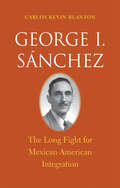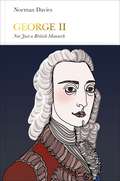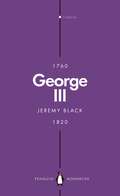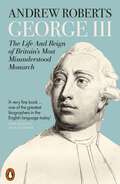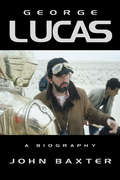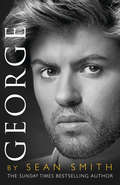- Table View
- List View
George I: The Lucky King (Penguin Monarchs)
by Tim BlanningGeorge I was not the most charismatic of the Hanoverian monarchs to have reigned in England but he was probably the most important. He was certainly the luckiest.Born the youngest son of a landless German duke, he was taken by repeated strokes of good fortune to become, first the ruler of a major state in the Holy Roman Empire of the German Nation and then the sovereign of three kingdoms (England, Ireland and Scotland). Tim Blanning's incisive short biography examines George's life and career as a German prince, and as King. Fifty-four years old when he arrived in London in 1714, he was a battle-hardened veteran, who put his long experience and deep knowledge of international affairs to good use in promoting the interests of both Hanover and Great Britain. When he died, his legacy was order and prosperity at home and power and prestige abroad. Disagreeable he may have been to many, but he was also tough, determined and effective, at a time when other European thrones had started to crumble.
George I. Sánchez: The Long Fight for Mexican American Integration (The Lamar Series in Western History)
by Carlos Kevin BlantonGeorge I. Sánchez was a reformer, activist, and intellectual, and one of the most influential members of the "Mexican American Generation" (1930–1960). A professor of education at the University of Texas from the beginning of World War II until the early 1970s, Sánchez was an outspoken proponent of integration and assimilation. He spent his life combating racial prejudice while working with such organizations as the ACLU and LULAC in the fight to improve educational and political opportunities for Mexican Americans. Yet his fervor was not always appreciated by those for whom he advocated, and some of his more unpopular stands made him a polarizing figure within the Latino community.Carlos Blanton has published the first biography of this complex man of notable contradictions. The author honors Sánchez’s efforts, hitherto mostly unrecognized, in the struggle for equal opportunity, while not shying away from his subject’s personal faults and foibles. The result is a long-overdue portrait of a towering figure in mid-twentieth-century America and the all-important cause to which he dedicated his life: Mexican American integration.
George II: Not Just a British Monarch (Penguin Monarchs)
by Norman DaviesFrom the celebrated historian and author of Europe: A History, a new life of George IIGeorge II, King of Great Britain and Ireland and Elector of Hanover, came to Britain for the first time when he was thirty-one. He had a terrible relationship with his father, George I, which was later paralleled by his relationship to his own son. He was short-tempered and uncultivated, but in his twenty-three-year reign he presided over a great flourishing in his adoptive country - economic, military and cultural - all described with characteristic wit and elegance by Norman Davies. (George II so admired the Hallelujah chorus in Handel's Messiah that he stood while it was being performed - as modern audiences still do.) Much of his attention remained in Hanover and on continental politics, as a result of which he was the last British monarch to lead his troops into battle, at Dettingen in 1744.
George III: Madness and Majesty (Penguin Monarchs)
by Jeremy BlackKing of Britain for sixty years and the last king of what would become the United States, George III inspired both hatred and loyalty and is now best known for two reasons: as a villainous tyrant for America's Founding Fathers, and for his madness, both of which have been portrayed on stage and screen.In this concise and penetrating biography, Jeremy Black turns away from the image-making and back to the archives, and instead locates George's life within his age: as a king who faced the loss of key colonies, rebellion in Ireland, insurrection in London, constitutional crisis in Britain and an existential threat from Revolutionary France as part of modern Britain's longest period of war.Black shows how George III rose to these challenges with fortitude and helped settle parliamentary monarchy as an effective governmental system, eventually becoming the most popular monarch for well over a century. He also shows us a talented and curious individual, committed to music, art, architecture and science, who took the duties of monarchy seriously, from reviewing death penalties to trying to control his often wayward children even as his own mental health failed, and became Britain's longest reigning king.
George III: The Life and Reign of Britain's Most Misunderstood Monarch
by Andrew RobertsAndrew Roberts, one of Britain's premier historians, overturns the received wisdom on George IIIGeorge III, Britain's longest-reigning king, has gone down in history as 'the cruellest tyrant of this age' (Thomas Paine, eighteenth century), 'a sovereign who inflicted more profound and enduring injuries upon this country than any other modern English king' (W.E.H. Lecky, nineteenth century), 'one of England's most disastrous kings' (J.H. Plumb, twentieth century) and as the pompous monarch of the musical Hamilton (twenty-first century).Andrew Roberts's magnificent new biography takes entirely the opposite view. It portrays George as intelligent, benevolent, scrupulously devoted to the constitution of his country and (as head of government as well as head of state) navigating the turbulence of eighteenth-century politics with a strong sense of honour and duty. He was a devoted husband and family man, a great patron of the arts and sciences, keen to advance Britain's agricultural capacity ('Farmer George') and determined that her horizons should be global. He could be stubborn and self-righteous, but he was also brave, brushing aside numerous assassination attempts, galvanising his ministers and generals at moments of crisis and stoical in the face of his descent - five times during his life - into a horrifying loss of mind.The book gives a detailed, revisionist account of the American Revolutionary War, persuasively taking apart a significant proportion of the Declaration of Independence, which Roberts shows to be largely Jeffersonian propaganda. In a later war, he describes how George's support for William Pitt was crucial in the battle against Napoleon. And he makes a convincing, modern diagnosis of George's terrible malady, very different to the widely accepted medical view and to popular portrayals. Roberts writes, 'the people who knew George III best loved him the most', and that far from being a tyrant or incompetent, George III was one of our most admirable monarchs. The diarist Fanny Burney, who spent four years at his court and saw him often, wrote 'A noble sovereign this is, and when justice is done to him, he will be as such acknowledged'. In presenting this fresh view of Britain's most misunderstood monarch, George III shows one of Britain's premier historians at his sparkling best.
George III's Children (Sutton Ser.)
by John Van KisteOn 12 August 1762, Queen Charlotte gave birth to her first child. Twenty-one years later, to the week, the 15th and youngest was born. All but two children survived to maturity. The eldest of King George III's children, who became Prince Regent and King George IV, is less remembered for his patronage of the arts than for his extravagance, and maltreatment of his wife Caroline. As Commander-in-Chief to the British army, the administrative qualities of Frederick, Duke of York are largely forgotten, while King William IV, usually dismissed as a figure of fun, brought a new affability to the monarchy which helped him through the storms engendered during the passage of the Great Reform Bill in 1832. The princesses, for many years victims of their parents' possessiveness, married late in life, if at all, and are passed off as non-entities. This objective portrayal of the royal family draws upon contemporary sources to lay to rest the gossip and exaggeration.
George IV: King in Waiting (Penguin Monarchs)
by Stella TillyardGeorge IV spent most of his life waiting to become king: as a pleasure-loving and rebellious Prince of Wales during the sixty-year reign of his father, George III, and for ten years as Prince Regent, when his father went mad. 'The days are very long when you have nothing to do' he once wrote plaintively, but he did his best to fill them with pleasure - women, art, food, wine, fashion, architecture. He presided over the creation of the Regency style, which came to epitomise the era, and he was, with Charles I, the most artistically literate of all our kings. Yet despite his life of luxury and indulgence, George died alone and unmourned. Stella Tillyard has not written a judgemental book, but a very human and enjoyable one, about this most colourful of all British kings.
George Lucas: A Life
by Brian Jay JonesAs The Last Jedi hits the screens, pick up George Lucas by Brian Jay Jones, the first comprehensive telling of the story of the iconic filmmaker and the building of his film empire, as well as of his enormous impact on cinema. At once a biography, a business manual, and a film history, George Lucas will, for the first time explore the life and work of a fiercely independent writer/director/producer who became one of the most influential filmmakers and cultural icons - a true game changer.On May 25, 1977, a problem-plagued, budget-straining, independent science fiction film opened in a mere thirty-two American movie theatres. Its distributor - 20th Century Fox - were baffled by the film. The film's production had been a disaster from nearly day one, hampered by bad weather, malfunctioning props and ill-fitting costumes. But its release on a quiet Wednesday in May of 1977, changed cinema forever. The film was Star Wars.The fiercely independent thirty-three year-old George Lucas was just getting going. Determined to control every element of the film-making process he had founded Lucasfilm ltd., in 1971. Among his hits, Lucas gave us six Star Wars films and four featuring the globetrotting archaeologist Indiana Jones. Together these ten films have earned more than $6 billion worldwide and won some of the largest and most devoted fan bases ever seen. In 2013 he sold Lucasfilm to Disney for $4.05 billion. Along the way the man who invented the Blockbuster also gave us computer generated imagery (CGI), created a small animation company called Pixar and reinvented the way movies were made, marketed and merchandised.
George Lucas (Text Only Edition): A Biography (text Only Edition)
by John BaxterThe first major biography (since 1983) of the great movie mogul George Lucas, whose marketing techniques have transformed the film business. His fourth Star Wars film, The Phantom Menace, released in 1999, was perhaps the most eagerly awaited cinematic event of all time.
George Mackay Brown
by Maggie FergussonGeorge Mackay Brown was one of Scotland's greatest twentieth-century writers, but in person a bundle of paradoxes. He had a wide international reputation, but hardly left his native Orkney. A prolific poet, admired by such fellow poets as Seamus Heaney, Ted Hughes and Charles Causley, and hailed by the composer Peter Maxwell Davies as 'the most positive and benign influence ever on my own efforts at creation', he was also an accomplished novelist (shortlisted for the 1994 Booker Prize for Beside the Ocean of Time) and a master of the short story. When he died in 1996, he left behind an autobiography as deft as it is ultimately uninformative. 'The lives of artists are as boring and also as uniquely fascinating as any or every other life,' he claimed. Never a recluse, he appeared open to his friends, but probably revealed more of himself in his voluminous correspondence with strangers. He never married - indeed he once wrote, 'I have never been in love in my life.' But some of his most poignant letters and poems were written to Stella Cartwright, 'the Muse of Rose Street', the gifted but tragic figure to whom he was once engaged and with whom he kept in touch until the end of her short life.Maggie Fergusson interviewed George Mackay Brown several times and is the only biographer to whom he, a reluctant subject, gave his blessing. Through his letters and through conversations with his wide acquaintance, she discovers that this particular artist's life was not only fascinating but vivid, courageous and surprising.
George & Martha Washington: A Revolutionary Marriage
by Flora FraserGeorge and Martha Washington, of Mount Vernon, Virginia, were America's original first couple. From the 1750s, when young soldier George wooed and wedded Martha Dandridge Custis, a pretty and rich young widow, to the forging of a new nation, Flora Fraser traces the development, both personal and political, of an historic marriage. The private sphere – their love of home and country, the two children Martha brings to this union from a previous marriage, and the confidence she instilled in her beloved second spouse – forms the backdrop to an increasingly public partnership. The leading role played by Virginia in the resistance to British taxation galvanised the pair, radicalising their politics, and in 1775 George Washington was appointed commander-in-chief of the American 'rebels'.In the eight harsh years of the American War of Independence which followed, Martha's staunch support for her husband never wavered. But the eventual victory at Yorktown in 1781 and Washington's retirement which followed were overshadowed by the death of her son, Jacky. Interweaving the progress and reversals of war - the siege of icebound Boston, the loss of New York and the crossing of the Delaware - with George and Martha's private joys and sorrows, this is a mesmerizing rendering of two formidable characters.Flora Fraser's revealing account is the first scholarly portrait of a union which owed its strength in equal measure to both parties. in a narrative enhanced by a close reading of personal, military and presidential papers, Fraser brings George and Martha Washington to life afresh: he, a man who aspired to greatness; and she, a woman who, when tested, proved an ideal spouse to commander and president alike.
George Mason, Forgotten Founder
by Jeff BroadwaterGeorge Mason (1725-92) is often omitted from the small circle of founding fathers celebrated today, but in his service to America he was, in the words of Thomas Jefferson, "of the first order of greatness." Jeff Broadwater provides a comprehensive account of Mason's life at the center of the momentous events of eighteenth-century America. Mason played a key role in the Stamp Act Crisis, the American Revolution, and the drafting of Virginia's first state constitution. He is perhaps best known as author of the Virginia Declaration of Rights, a document often hailed as the model for the Bill of Rights.As a Virginia delegate to the Constitutional Convention in Philadelphia, Mason influenced the emerging Constitution on point after point. Yet when he was rebuffed in his efforts to add a bill of rights and concluded the document did too little to protect the interests of the South, he refused to sign the final draft. Broadwater argues that Mason's recalcitrance was not the act of an isolated dissenter; rather, it emerged from the ideology of the American Revolution. Mason's concerns about the abuse of political power, Broadwater shows, went to the essence of the American experience.
George Meléndez Wright: The Fight for Wildlife and Wilderness in the National Parks
by Jerry EmoryThe first biography of a visionary biologist whose groundbreaking ideas regarding wildlife and science revolutionized national parks. When twenty-three-year-old George Meléndez Wright arrived in Yosemite National Park in 1927 to work as a ranger naturalist—the first Hispanic person to occupy any professional position in the National Park Service (NPS)—he had already visited every national park in the western United States, including McKinley (now Denali) in Alaska. Two years later, he would organize the first science-based wildlife survey of the western parks, forever changing how the NPS would manage wildlife and natural resources. At a time when national parks routinely fed bears garbage as part of “shows” and killed “bad” predators like wolves, mountain lions, and coyotes, Wright’s new ideas for conservation set the stage for the modern scientific management of parks and other public lands. Tragically, Wright died in a 1936 car accident while working to establish parks and wildlife refuges on the US-Mexico border. To this day, he remains a celebrated figure among conservationists, wildlife experts, and park managers. In this book, Jerry Emory, a conservationist and writer connected to Wright’s family, draws on hundreds of letters, field notes, archival research, interviews, and more to offer both a biography of Wright and a historical account of a crucial period in the evolution of US parks and the wilderness movement. With a foreword by former NPS director Jonathan B. Jarvis, George Meléndez Wright is a celebration of Wright’s unique upbringing, dynamism, and enduring vision that places him at last in the pantheon of the great American conservationists.
George Meléndez Wright: The Fight for Wildlife and Wilderness in the National Parks
by Jerry EmoryThe first biography of a visionary biologist whose groundbreaking ideas regarding wildlife and science revolutionized national parks. When twenty-three-year-old George Meléndez Wright arrived in Yosemite National Park in 1927 to work as a ranger naturalist—the first Hispanic person to occupy any professional position in the National Park Service (NPS)—he had already visited every national park in the western United States, including McKinley (now Denali) in Alaska. Two years later, he would organize the first science-based wildlife survey of the western parks, forever changing how the NPS would manage wildlife and natural resources. At a time when national parks routinely fed bears garbage as part of “shows” and killed “bad” predators like wolves, mountain lions, and coyotes, Wright’s new ideas for conservation set the stage for the modern scientific management of parks and other public lands. Tragically, Wright died in a 1936 car accident while working to establish parks and wildlife refuges on the US-Mexico border. To this day, he remains a celebrated figure among conservationists, wildlife experts, and park managers. In this book, Jerry Emory, a conservationist and writer connected to Wright’s family, draws on hundreds of letters, field notes, archival research, interviews, and more to offer both a biography of Wright and a historical account of a crucial period in the evolution of US parks and the wilderness movement. With a foreword by former NPS director Jonathan B. Jarvis, George Meléndez Wright is a celebration of Wright’s unique upbringing, dynamism, and enduring vision that places him at last in the pantheon of the great American conservationists.
George: A Memory of George Michael
by Sean SmithGeorge is the story of two extraordinary lives – the private man and the public legend.
George Meredith and English Comedy: The Clark Lectures for 1969 (The\clark Lectures For 1969)
by V. S. Pritchett'It is because we learn from the writers who have either got into difficulties or who have a certain vanity in creating them, that I have chosen Meredith as my subject', says Mr. Pritchett at the beginning of these Clark Lectures for 1969. The Meredith who, as Henry James remarked, 'did the best things best', but whose novels some critics have written off, was in some ways the forerunner of the contemporary novel, its erratic movement, its profusion of metaphor. His strange style was a device for linking his Romance to a real world, and Mr. Pritchett believes that the difficulties of this style have been in any case exaggerated. What he aimed at was comedy; but comedy 'conceived of as theatre'. 'The business of comedy is ruthlessly to expose the false emotions and the false image of oneself.' Meredith's great virtues as a writer of comedy were his power to analyse states of mind and his gift for slipping out of one mind into another. Mr. Pritchett illuminates these virtues no less than Meredith's defects with brilliant commentaries on Beauchamp's Career, The Ordeal of Richard Feverel, Evan Harrington, Harry Richmond and The Egoist. A passionate feminist, a romantic poet with a leaning to the mythic, a champion of intelligence and the values which spring from it, Meredith wrote novels whose originality can be clearly seen from Mr. Pritchett's fresh viewpoint.
George Michael: The biography
by Rob JovanovicGeorge Michael is an enigma. While he is one of the most open and vocal pop superstars on the planet, he also fiercely protective of his privacy. From the formation of Wham! In 1981 he immediately found fame and fortune beyond his wildest dreams. His music formed the soundtrack to the 1980s and he achieved all of this despite growing up in a dysfunctional family where his father openly proclaimed that George had no talent.Wham! split in 1986 but Michael went on to greater things as a solo artist. Along the way he has been embroiled in several controversies, but in refreshing contrast to other superstars, he has been happy to address his issues head-on in the media. Rob Jovanovic's biography tackles all the issues that formed George Michael and his place as a cultural icon. It also, for the first time, analyses Michael's musical output and groundbreaking videos.
George Orwell: A Biography
by Gordon Bowker'Adds enormously to our understanding of the man' Evening StandardGeorge Orwell was one of the greatest writers England produced in the last century. He left an enduring mark on our language and culture, with concepts such as 'Big Brother' and 'Room 101.' His reputation rests not only on his political shrewdness and his sharp satires (Animal Farm and Nineteen Eighty-Four) but also on his marvellously clear style and superb essays, which rank with the best ever written. Gordon Bowker's new biography includes fascinating new material which brings Orwell'slife into unfamiliar focus. He writes revealingly about Orwell's family background; the lasting influence of Eton on his work and character; his superstitious streak and youthful flirtation with black magic; and his chaotic and reckless sex life, which included at least one homoerotic relationship. It highlights the strange circumstances of his first marriage and provides remarkable new evidence of his experiences in Spain and their nightmarish consequences. It also offers a fresh look at his peculiar deathbed marriage to a woman fifteen years his junior. All this has enabled Bowker to give Orwell's life a brilliantly fresh and distinctive interpretation.
George Orwell: A Life In Letters (Penguin Modern Classics)
by George Orwell Peter DavisonPersonal as well as political, Orwell's letters offer a fascinating window into the mind of a phenomenal man. We are privy to snatched glimpses of his family life: his son Richard's developing teeth, the death of his wife Eileen, and his own illness. Candid portraits of Barcelona during the Spanish Civil War, his opinions on bayonets, and on the chaining of German prisoners display his magnificent talent as a political writer, and letters to friends and his publisher provide a unique insight into the development and publication of some of the most important novels in the English language. A Life in Letters features previously unpublished material, including letters which shed new light on a love that would haunt him for his whole life, as well as revealing the inspiration for some of his most famous characters. Presented for the first time in a dedicated volume, this selection of Orwell's letters is an indispensible companion to his diaries.
George Osborne: The Austerity Chancellor
by Janan Ganesh"Ganesh's dissection of what has driven the intellectual and political revival of the Tories is forensic and incisive."- Anne McElvoy, Mail on Sunday"A lively account of the Chancellor's career ... contains a great deal of fascinating new information."- Peter Oborne, Daily Telegraph George Osborne is the most controversial Chancellor of the Exchequer since the Second World War. His austere policies have incited international debate, and his political influence over the government provokes resentment. He is also a survivor with an eye on the premiership. Having authored the most hated Budget of recent times, he now presides over a recovering economy.This is the story of Osborne's breathless ascent to power: a journey driven by luck, guile, resilience, daring and ferocious ambition. As a back-room adviser, MP and Cabinet member, he has enjoyed a starring role or front-row seat at all the Tory dramas since the fall of Thatcher and the dog days of the Major government, from the party's long years in opposition to its eventual and incomplete resurrection. Yet rarely have voters known so little about a politician with such sway over their lives and livelihoods.Fully updated to include Osborne's role in the economic recovery, his appointment of Mark Carney as Governor of the Bank of England, and his prospects as a future Prime Minister, this biography makes sense of a man who is both a personal enigma and a political machine. Based on exhaustive research and access to the innermost parts of the government, it tells the story of George Osborne and the era he has helped to shape.
George Platt Lynes: The Daring Eye
by Allen EllenzweigGeorge Platt Lynes: The Daring Eye is a life of the gregarious American portrait, dance, fashion, and male nude photographer whose career spanned the late 1920s to 1955. From age 18, Lynes entered the cosmopolitan world of the American expatriate community in Paris when he became acquainted with the salon of Gertrude Stein and Alice B. Toklas. Intending to pursue a literary and small press publishing career, Lynes also began photographing authors like Stein, Jean Cocteau, André Gide, and Colette. Soon, he turned exclusively to photography, establishing himself as one of the premier fashion photographers in the Condé Nast stable, documenting the early ballets of George Balanchine, and pursuing his private obsession with seductive images of young male nudes almost never published in his time. Lynes's private life was as glamorous and theatrical as his images with their brilliant studio lighting and dramatic Surrealist set-ups. Barely out his teens, he met the publisher Monroe Wheeler who was already in a relationship with the emerging expatriate novelist Glenway Wescott. The peripatetic threesome maintained a polyamorous connection that lasted some 15 years. Their New York apartment became a mecca for elegant cocktail and name-dropping dinner parties. Their ménage-à-trois complicates our understanding of the pre-Stonewall gay "closet." This biography, drawing upon intimate letters and an unpublished memoir of Lynes's life by his brother, writer and editor Russell Lynes, paints a portrait of the emerging influence of gays and lesbians in the visual, literary, and performing arts that defined transatlantic cosmopolitan culture and presaged later gay political activism.
George Platt Lynes: The Daring Eye
by Allen EllenzweigGeorge Platt Lynes: The Daring Eye is a life of the gregarious American portrait, dance, fashion, and male nude photographer whose career spanned the late 1920s to 1955. From age 18, Lynes entered the cosmopolitan world of the American expatriate community in Paris when he became acquainted with the salon of Gertrude Stein and Alice B. Toklas. Intending to pursue a literary and small press publishing career, Lynes also began photographing authors like Stein, Jean Cocteau, André Gide, and Colette. Soon, he turned exclusively to photography, establishing himself as one of the premier fashion photographers in the Condé Nast stable, documenting the early ballets of George Balanchine, and pursuing his private obsession with seductive images of young male nudes almost never published in his time. Lynes's private life was as glamorous and theatrical as his images with their brilliant studio lighting and dramatic Surrealist set-ups. Barely out his teens, he met the publisher Monroe Wheeler who was already in a relationship with the emerging expatriate novelist Glenway Wescott. The peripatetic threesome maintained a polyamorous connection that lasted some 15 years. Their New York apartment became a mecca for elegant cocktail and name-dropping dinner parties. Their ménage-à-trois complicates our understanding of the pre-Stonewall gay "closet." This biography, drawing upon intimate letters and an unpublished memoir of Lynes's life by his brother, writer and editor Russell Lynes, paints a portrait of the emerging influence of gays and lesbians in the visual, literary, and performing arts that defined transatlantic cosmopolitan culture and presaged later gay political activism.
George & Robert Stephenson: A Passion for Success (History Press Ser.)
by David RossFrom poverty to immense wealth, from humble beginnings to international celebrity, George and Robert Stephenson's was an extraordinary joint career. Together they overshadow all other engineers, with the possible exception of Robert's friend Isambard Kingdom Brunel, for one vital reason: they were winners. For them it was not enough to follow the progress made by others. They had to be the best. Colossal in confidence, ability, energy and ambition, George Stephenson was also a man of huge rages and jealousies, determined to create his own legend. Brought up from infancy by his father, Robert was a very different person. Driven by the need to be the super-successful son his father wanted, he struggled with self-distrust and morbid depression. More than once his career and reputation teetered on the edge of disaster. But by being flawed, he emerges as a far more appealing and sympathetic figure than the conventional picture of the 'eminent engineer.' David Ross's new biography of George and Robert Stephenson sheds new light on these two giants of British engineering.
George Sand: A Woman's Life Writ Large
by Belinda Jack'George Sand' (Aurore Dupin, 1804-1876) was France's bestselling writer, rivalled in her time only by Victor Hugo. She was at the centre of French intellectual and artistic life: her circle included Liszt and Delacroiz, Blazac and Flaubert. Yet she was known as much for her excessive life as for her plays, stories and enduring novels like Indiana, Lelia and Mauprat. The daughter of a prostitute and an aristocrat, Sand grew up acutely aware of social injustice and prejudice. Convent-educated, she became a mischievous, flamboyant rebel: her long, troubled romance with Chopin was just one of many affairs with well-known figures, but her most desperate love was for a beautiful actress.
George Santayana: A Biography
by John McCormickFrom the late nineteenth century to the middle of the twentieth, George Santayana was a highly esteemed and widely read writer of philosophy, poetry, essays, memoirs, and even a best-selling novel, The Last Puritan. After a period of relative neglect, interest in his work has revived. A complete edited edition of his works is in progress and he has become the object of renewed scholarly activity. Contributing significantly to the renewal was John McCormick's 1987 biography, the first full-scale volume to treat an elusive figure's life and thought in the detail they deserve.Santayana's life was rich in its interior and outer associations. There was his birth and early childhood in Spain followed by a move to Boston, where he came under the influence of William James at Harvard. This led to his career at Harvard as a professor, where Wallace Stevens, Robert Frost, Conrad Aiken, Franklin D. Roosevelt, and Walter Lippmann were among his devoted students. We see Santayana in correspondence and conversation with Bertrand Russell, G.E. Moore, Ezra Pound, and Robert Lowell.Predominant in Santayana's life was his philosophical work. Hostile to the dominant empiricism of Anglo-American philosophy, he left the academy and remained detached from both the political and ideological movements of early decades of the twentieth century. McCormick relates his skepticism and materialism to a form of idealism deriving from his classical education in Plato and Aristotle, together with his readings in Descartes and Spinoza. He presents Santayana as a supreme stylist in English, who lived a long life always consistent with his stoic epicureanism.

